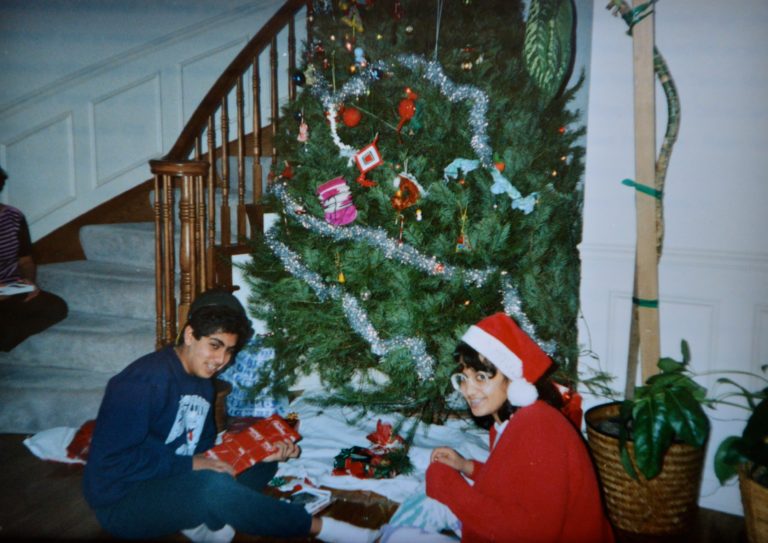
Image by Courtesy of Monisha Bajaj.
How to Make Meaning of the Holidays as a Non-Christian
The recent media attention to whether Jesus was white, whether Santa is white, and the so-called “war on Christmas” distract from a question that has plagued me my whole life: What’s a non-Christian South Asian American to do during Christmas?
Growing up, my Indian immigrant family had a variety of responses to the holiday season. My mom, who attended Catholic schools in India as a child, was particularly fond of the holiday. She always wanted a tree and took us to take photos with Santa at the mall. One year, she even had our Catholic babysitter take us to midnight Mass. That night, my brother and I followed Sandra’s children up to the priest to get communion — and were angrily yelled at by a parishioner for not knowing what to do after receiving it. We never returned to that service.
Another year, after my grandfather died, we were extending the usual Hindu tradition of no celebrations for 13 days after a death, but my mom still insisted on making a tree shape out of lights to hang in our window. It seemed as if, rather than the repetition of traditions, our holiday season was marked by the search for them.
There were always gifts (on Diwali and, soon after, on Christmas) and time together as my parents, who both worked full time, were around more. We often had visits from family who were scattered around the U.S. or other Indian immigrant families taking advantage of the time away from work at liquor stores, driving taxis, or at hospitals and tech companies. Since college, my holiday traditions became related to overseas travel over the long break as a student and then as a professor.
As a new mother this year, I have started my own quest for tradition. My partner and I are raising a child who has Hindu, Sikh, and Christian heritage. We want to pass down some aspects of our experiences as South Asian Americans.
My husband grew up in a Syrian Christian community of south India, a community that traces its lineage to Saint Thomas and the many versions of Christianity that have developed in the country since the 1st century AD.
However, my partner has not been a practicing Christian for over two decades. We recently bought a tree. I love the smell and the somewhat-hidden history of ancient Egyptians displaying evergreen boughs around the winter solstice as a symbol of renewal, regeneration, and life over death. (Reportedly, the tradition of decorated trees in homes came to the United States via German settlers in the 1800s.)

We’ve decided to call our tree a “family tree” and, instead of lights and store-bought ornaments, we put photos of relatives, loved ones, ancestors, and small items that represent our families on the branches. It reminds me a bit of the Dia de Los Muertos altars I saw Chicano friends putting together when I was growing up in California. But we have plenty of “living” and other images — my newborn nephew’s photo, an ornament made in grade school by my brother, and a set of handmade paper mâché stars bought on a family trip to Goa when I was eight years old.
Who knows if the tradition will stick. We may keep searching with no firm outcome as my family did. I imagine this is what many immigrant families to the U.S. have done. In fact, belief in Santa Claus and his reindeers, the displaying of trees, and the drinking of egg nog were all brought by immigrants from different parts and “indigenized” here in the U.S. over time.
Regardless of where our family traditions end up, for now, looking at pictures of loved ones past and present, with the smell of pine, brings us smiles and feelings of gratitude as we begin a new year full of promise.

Share your reflection